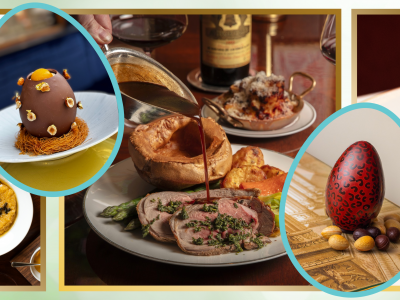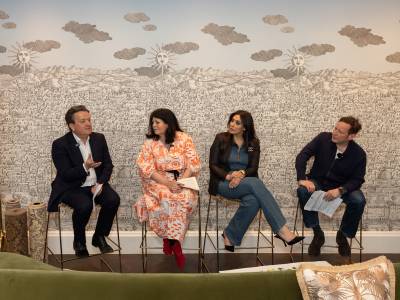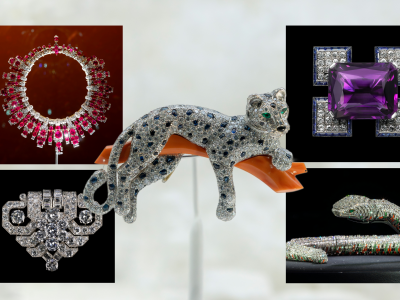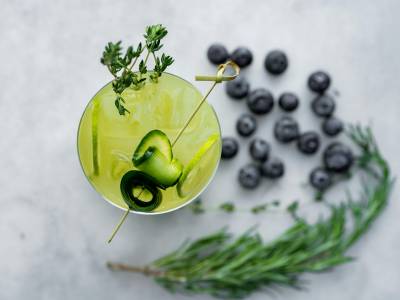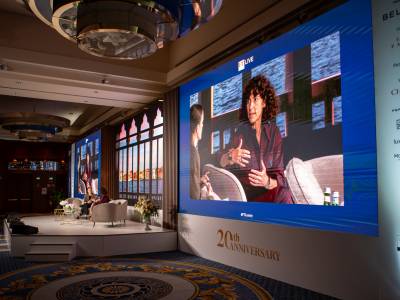Some of the most fêted fashion and couture houses on the planet are bringing their sense of style to the world of cuisine yet, historically speaking, luxury fashion has not shared a close relationship with food. Yesterday’s style-obsessed designer acolytes were more synonymous with Diet Coke and cigarettes than pasta and fries. A trip to an upmarket boutique might have involved a glass of Champagne, but little else.
Where Couture Meets Cuisine
13th July 2023
Fashion and food haven't always made perfect partners, not least because fashion folk are known to prefer Champagne over a champignon. But, no longer. SPHERE explores the global hotspots where couture meets cuisine and results in delicious food from Prada, Dior and Gucci. Who else?

But, recent months have seen a shift towards a tantalising new trend, with many of fashion's bold-faced brands establishing dedicated food spaces combining the height of couture with the crème de la crème of cuisine. In short, the chance to nibble on a sticky Dior pastry or a succulent Gucci burger is becoming increasingly possible for fashion fans everywhere.
“We have predicted the blurring between fashion and the food and drink industry for some time,” says Jennifer Creevy, director of food and drink at trend forecaster WGSN. “Now this is coming to fruition, with fashion brands opening up bars and restaurants, and moving into the drinks and snacking space.”

Though fashion brands experimenting with lifestyle offerings isn’t exactly new — whether it’s beauty, homeware, or even hotels, chances are, it’s been done — it is notoriously tricky to make a dent in the realm of food and beverage, even for names with a luxury pedigree.
As a result, while the occasional designer eatery has surfaced over the years — one notable example being harbinger Chanel launching fine dining restaurant Beige in Tokyo in 2004, in collaboration with Ducasse Paris — it’s only now that we’re seeing fashion houses really sinking their teeth into the idea.

Where Couture Meets Cuisine Now
Take Paris as an example. There, well-heeled diners are fighting to get a table at the new Monsieur Dior restaurant (32 Avenue Montaigne); a space that’s as dressed to impress as its clientele.
An integral aspect of Dior’s 10,000-square-metre Avenue Montaigne HQ— and a first for the French flagship, following its recent head-to-toe renovation — the Peter Marino-designed interior sees designer-clad waiters circle an airy dining room replete with the maison’s signature codes, such as houndstooth-patterned seating. A gigantic Guy Limone art wall is collaged with over 1,000 vintage cut-outs showing Dior’s archive of collections.

In the kitchen, French chef Jean Imbert crafts cuisine inspired by the life of the real Monsieur Dior, from a soft-boiled egg served on a bed of caviar — a favourite childhood dish — to the entrecôte frites du defile the designer was said to have indulged in before every catwalk show. Imbert also helms the on-site Pâtisserie Dior, a more casual eatery dedicated to coffee and pastries.
Other designer sweet shops are gaining pace elsewhere at LVMH. In December, the luxury conglomerate launched a pop-up patisserie (248 Rue Sainte Croix de la Bretonnerie) in collaboration with its Paris-based fashion e-com brand, 24S.
Its sugary confections were modelled after iconic styles stocked on the 24S platform, including a Fendi First bag spun from meringue and mousse, and a raspberry financier-cum-cheesecake shaped to resemble the Balmain six-button jacket.
“Like Parisian fashion and luxury, pastry is the ultimate symbol of the French way of life,” says Tal Spiegel, 24S Pâtisserie’s pastry chef. “Both are the result of passion combined with craftsmanship. Not everyone can afford the pieces on 24S, so we wanted to offer an accessible luxury experience for fashion lovers, at a more affordable price point.”
Meanwhile, in London, Anya Hindmarch has reopened her summer gelato store, The Ice Cream Project, where ice-creams comes in idiosyncratic British flavours, including Heinz Tomato Soup and Branston Pickle.

Back in Paris, Maxime Frédéric at Louis Vuitton — named for its star pastry chef — is a new café and chocolate shop located within the recently launched LV Dream cultural exhibition space in Paris (2 Rue du Pont Neuf). Visitors can indulge in a variety of treats, from bonbons to cakes and beyond. Confectionery comes detailed with Louis Vuitton iconography, such as the Damier Ebène checkerboard; each edible creation is meticulously crafted by hand using the same artisanal savoir-faire that is applied to the brand’s signature trunks.

In the UK, following the success of a Café Dior winter pop-up, spring saw Harrods Knightsbridge open the doors to its new Prada Caffè, open until January 2024. With tasteful décor awash in pastel Prada green, complemented by a monochrome chequered floor reminiscent of the one in the label’s inaugural 1913 boutique, the design borrows inspiration from one of Milan’s most historic patisseries, Pasticceria Marchesi (Via Santa Maria Alla Porta 11/a).

Continuing the Italian theme, dishes include pizzettes, cannelloni and tramezzini sandwiches, served on exclusive Prada tableware alongside branded crystal glasses. Diners can round off proceedings with a negroni sbagliato cocktail, or enjoy a gelato to go from the ice cream stall positioned outside the Hans Road entrance. Prada Caffè’s menu describes how the activation “adds a new dimension to the Prada brand” offering “an engaging and stimulating experience” that “reflects Prada’s tastes and passions.”

While Europe is starting to experiment with luxury branded cafés and restaurants, East Asia has been at the forefront of the trend from the start. In fact, numerous luxury brands have debuted their concept cuisine in countries such as China and Japan before installing activations in other regions.
Recent East Asian launches have included Ralph’s Bar in Chengdu — an old-school restaurant and bar concept from Ralph Lauren that combines classic design with Stateside-themed cuisine and an impressive range of American whiskies. Other examples include a Café Kitsuné in Singapore, plus Maison Margiela Café pop-ups in Shanghai and Shenzhen.

In Seoul, Gucci recently opened its latest Osteria restaurant — to no small degree of anticipation among South Koreans, given that several of the brand’s other Osteria outposts have scooped a Michelin star. The kitchen is led by chefs Hyungkyu Jun and Davide Cardellini, who together rework classic Italian fare with a contemporary Korean twist. Gucci’s signature, super-indulgent Emilia Burger sits in pride of place on the menu, here combining a cotechino patty with hanwoo beef, topped with salsa verde and sticky balsamic.
For today’s hyper-visual, Insta-happy consumer, these stylishly curated fashion-meets-food initiatives appear to work as a savvy marketing approach. They make it easier for younger or aspirational shoppers to savour a taste of the luxury lifestyle; they also enhance the value and desirability of bricks-and-mortar boutiques, tempting shoppers back into stores.

Creevy agrees. “Fashion used to be the biggest cultural concern for younger generations; now, food and drink is as important a status symbol,” she says. “The food and drink brands that consumers choose are now very much a part of who they are and what they stand for, as much as the clothes that they wear. Fashion houses are understanding these changing values and moving into this space to align with future consumers.”
As more designer-branded eateries open, is there a risk of diluting the exclusivity factor of a luxury maison — or even causing consumer fatigue? Creevy disagrees, “Food brands now deliver as much cool currency as fashion brands.”
So, who's next to join the couture meets cuisine story? We're holding out for an Hermes Afternoon tea.



